Understanding the Updated CDC Guidelines for Childhood Vaccinations in the US (2025)

Understanding the Updated CDC Guidelines for Childhood Vaccinations in the US (2025) is crucial for ensuring children receive optimal protection against preventable diseases, reflecting the latest scientific evidence and public health priorities.
Navigating the landscape of childhood vaccinations can often feel overwhelming for parents. In 2025, staying informed about the Understanding the Updated CDC Guidelines for Childhood Vaccinations in the US (2025) is essential for protecting your child’s health and contributing to community immunity.
The Importance of Staying Updated on Vaccination Guidelines
Remaining vigilant regarding changes in vaccination guidelines is pivotal for several reasons. These updates generally reflect advancements in medical science, emerging disease patterns, and a deeper comprehension of vaccine efficacy and safety.
Changes to the schedule can be influenced by a number of factors, including new vaccines become available, the prevalence of certain diseases changes, or as we learn more about how vaccines work.
Why Guidelines Change
Vaccination guidelines aren’t static; they evolve as new scientific evidence emerges. These changes are driven by:
- Ongoing research into vaccine effectiveness and duration of immunity.
- Monitoring of disease outbreaks and prevalence.
- The evaluation of new vaccines and their integration into existing schedules.
Consequences of Outdated Information
Relying on outdated information can lead to several adverse outcomes:
- Incomplete protection against preventable diseases.
- Exposure to unnecessary risks due to delayed or omitted vaccinations.
- Lack of herd immunity, which can endanger vulnerable populations.
- Potential spreading some Diseases throughtout the Community

Staying informed is key to ensuring that children are fully protected and that the community benefits from optimal herd immunity. By embracing the updates, parents and healthcare providers can work together to safeguard the health of future generations.
Overview of the CDC’s Role in Vaccination Recommendations
The Centers for Disease Control and Prevention (CDC) plays a crucial role in shaping vaccination recommendations in the United States. It serves as a trusted, evidence-based authority that health professionals and the public rely on.
These Recommendations are the ones that help create the best protection for people in the US, and it’s important to know more about them.
How the CDC Develops Recommendations
The CDC’s vaccination recommendations are developed through a rigorous, multi-step process:
- Data Collection: The CDC gathers extensive data on disease prevalence, vaccine effectiveness, and potential side effects.
- Expert Review: The Advisory Committee on Immunization Practices (ACIP), a panel of medical and public health experts, reviews the data.
- Public Input: Opportunities for public comment and feedback are incorporated into the decision-making process.
Key Resources Provided by the CDC
The CDC offers an array of resources to help healthcare providers and the public understand vaccination guidelines:
The ACIP meets several times a year to review data and make recommendations, all of which are publicly available as meeting minutes and official statements.
- Official Vaccination Schedules: Comprehensive schedules tailored to different age groups and medical conditions.
- Educational Materials: Fact sheets, brochures, and online resources explaining the importance of vaccinations.
- Health Advisories: Updates on emerging infectious diseases and any necessary changes to vaccination protocols.
- Pink Book: Epidemiology and Prevention of Vaccine-Preventable Diseases
The CDC’s vaccination recommendations are a cornerstone of public health efforts to prevent and control infectious diseases. By adhering to these guidelines, the risk of vaccine-preventable diseases is mitigated for individuals in communities.

Key Updates in the 2025 Guidelines
The 2025 CDC guidelines for childhood vaccinations incorporate several important updates that reflect new scientific insights, changes in disease prevalence, and the introduction of new or improved vaccines.
Let’s take a closer look at some of the most significant changes.
Changes to Vaccine Schedules
Key updates to the vaccine schedule may include:
Some new vaccines are now available, while recommendations have been updates for familiar options like the flu.
New Vaccines Added
- RSV Vaccine: For preventing respiratory syncytial virus (RSV) in infants and young children.
- Updated Influenza Vaccines: Enhanced flu shots designed to offer broader protection against prevalent strains.
Updates to Existing Vaccines
- Revised Dosage Schedules: Adjustments to the timing and number of doses for certain vaccines to optimize immunity.
- Expanded Age Recommendations: Extension of vaccine eligibility to include a wider age range for specific populations.
Addressing Emerging Health Threats
With evolving global health concerns, the CDC has adapted its guidelines to address emerging threats such as:
- COVID-19: Updated recommendations for pediatric COVID-19 vaccination, including booster schedules.
- Monkeypox: Guidance on vaccination for at-risk children and adolescents.
In 2025, awareness of these key updates ensures that healthcare providers and parents are equipped to implement the most effective vaccination strategies for protecting children’s health.
Vaccination Schedule for Infants and Young Children
The vaccination schedule for infants and young children is carefully designed to provide protection during the most vulnerable stages of life.
Starting from birth, infants receive a series of vaccines to build immunity against potentially life-threatening diseases.
Birth to 12 Months
Infants typically receive vaccines for:
- Hepatitis B (HepB): Usually given shortly after birth.
- Rotavirus (RV): Prevents severe diarrheal disease.
- Diphtheria, Tetanus, and Pertussis (DTaP): Protects against these serious bacterial infections.
- Haemophilus influenzae type b (Hib): Prevents invasive diseases.
- Pneumococcal Conjugate Vaccine (PCV13): Guards against pneumococcal infections.
- Inactivated Poliovirus Vaccine (IPV): Protects against polio.
12 Months to 2 Years
As children enter their second year, their vaccination schedule includes:
- Measles, Mumps, and Rubella (MMR): Protects against these viral diseases.
- Varicella (VAR): Prevents chickenpox.
- Hepatitis A (HepA): Protects against liver infection.
- Additional doses of DTaP, Hib, PCV13, and IPV.
Following the recommended vaccination schedule for infants and young children is essential for providing early protection and establishing a strong foundation for long-term health.
Vaccination Schedule for Older Children and Adolescents
As children grow and enter adolescence, the vaccination schedule shifts to address health risks specific to these age groups.
Vaccines given during this time protect against diseases that are more common or severe among older children and teenagers.
4 to 6 Years
Before starting school, children typically receive:
- Final doses of DTaP, IPV, MMR, and VAR vaccines.
11 to 12 Years
This is a crucial period for several important vaccinations:
- Tetanus, Diphtheria, and Pertussis (Tdap): A booster to continue protection against these diseases.
- Human Papillomavirus (HPV): Protects against HPV-related cancers and genital warts.
- Meningococcal Conjugate Vaccine (MenACWY): Guards against meningococcal disease.
16 to 18 Years
Adolescents may need:
- Meningococcal B Vaccine (MenB): Provides additional protection against meningococcal disease.
- Influenza Vaccine: Annual vaccination is recommended for all age groups.
Staying up-to-date with vaccinations during childhood and adolescence is crucial for maintaining long-term health and preventing serious infections. By adhering to the recommended schedule, young people can protect themselves and contribute to community immunity.
Addressing Common Concerns and Misconceptions
Despite the overwhelming scientific consensus supporting the safety and effectiveness of vaccines, common concerns and misconceptions persist.
Addressing these concerns with accurate information is crucial for promoting informed decision-making.
Debunking Common Myths
Some prevalent myths include:
Vaccines cause autism, vaccines are not necessary, and vaccines contain dangerous ingredients.
- Myth: Vaccines cause autism.
Fact: Numerous scientific studies have debunked any link between vaccines and autism. - Myth: Vaccines are not necessary because diseases are rare.
Fact: Vaccines have dramatically reduced the incidence of many diseases, but these diseases can return if vaccination rates decline. - Myth: Vaccines contain dangerous ingredients.
Fact: Vaccine ingredients are carefully regulated and present in amounts that are safe for children.
Discussing Potential Side Effects
While vaccines are generally safe, mild side effects can occur:
These side effects are typically mild and temporary, such as fever, redness, or swelling at the injection site.
- Fever: A mild fever may occur but usually resolves within a day or two.
- Redness or Swelling: These reactions at the injection site are common and typically mild.
- Soreness: Some children may experience soreness or tenderness at the injection site.
Understanding the facts about vaccines and addressing common concerns can help parents make informed decisions about their children’s health.
| Key Point | Brief Description |
|---|---|
| 🗓️ Updated CDC Guidelines | Reflect the latest in vaccine science and disease patterns. |
| 💉 New Vaccines | Include RSV vaccine and enhanced flu shots for broader protection. |
| 🛡️ Importance of Vaccination | Essential for protecting children and contributing to herd immunity. |
| ❗ Addressing Concerns | Debunking myths and providing accurate information on side effects. |
Frequently Asked Questions (FAQs)
▼
Vaccination guidelines are updated to reflect new scientific evidence, changes in disease prevalence, and the availability of new vaccines. Staying current ensures the best protection.
▼
The updated CDC vaccination schedule is available on the CDC’s official website and through your healthcare provider. These resources provide comprehensive details on recommended vaccinations.
▼
Yes, the 2025 guidelines may include new vaccines such as the RSV vaccine for infants and updated influenza vaccines, offering broader protection against respiratory illnesses.
▼
If your child has missed a vaccine, contact your healthcare provider to schedule a catch-up appointment. Following the recommended schedule ensures timely protection against preventable diseases.
▼
Vaccines are rigorously tested and monitored for safety. Serious side effects are rare, and the benefits of vaccination far outweigh the risks of contracting vaccine-preventable diseases.
Conclusion
Understanding the Updated CDC Guidelines for Childhood Vaccinations in the US (2025) is vital for safeguarding the health of children and fostering community immunity. By staying informed, addressing concerns with accurate information, and adhering to the recommended schedules, parents and healthcare providers can collectively ensure a healthier future for generations to come. Embrace the changes, prioritize vaccinations, and empower your children to live healthier, safer lives.





